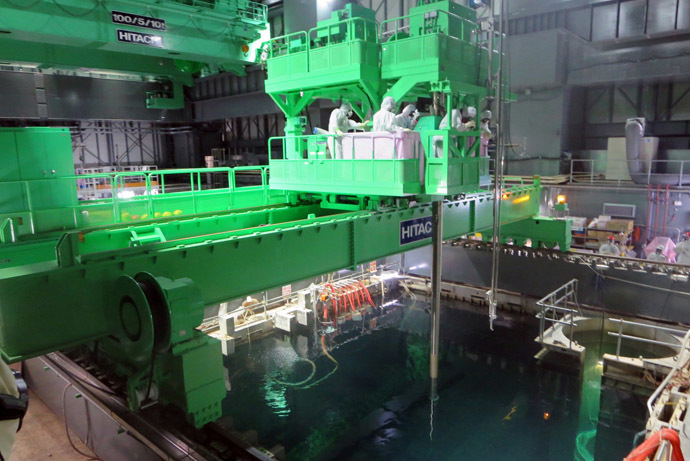Radioactive leaks continue to plague Fukushima, new Unit 3 problem found

Highly radioactive water, believed to have leaked from one of the damaged reactors, has been detected inside Unit 3 Reactor at the compromised Fukushima Daiichi nuclear plant. There's been no leakage to the outside of the building, TEPCO announced.
According to Asia's largest utility, the Tokyo Electric Power Company (TEPCO), water leakage was identified for the first time by a robot removing debris on the first floor of Unit 3 Reactor at the Fukushima plant. Video filmed by the robot shows highly radioactive water, found to contain high levels of radioactive cesium and cobalt. On Saturday, one of the workers who was busy monitoring the robotic device's screen, discovered that water was leaking to the drainage ditch in the northeast area of first floor, where the main steam isolation valve is located.
The reactor has been steadily cooled. The company said it will continue investigating the cause and the spot of the leakage, without interrupting the decommissioning work.
Since the outbreak of the Fukushima disaster in March 2011, leakage of radiation-contaminated water has posed a major threat to Japan’s population and environment, and to the international community.
The operator of the stricken atomic plant has been using robotic devices to remove the debris inside the Unit 3 Reactor building since July 2013, when TEPCO acknowledged the fact that contaminated water has been escaping from basements and trenches of the Fukushima plant into the ocean. Since then, the operator reported two major leaks of highly radioactive water into the ocean from storage tanks – a 300-ton leak in August and 430 liters in October.
In March 2011 an earthquake triggered a tsunami that hit Japan’s coast, damaging the Fukushima Daiichi nuclear power plant. The catastrophe caused the meltdown of three nuclear reactors at the facility, leading to the worst nuclear disaster since Chernobyl. Almost three years later, TEPCO is still facing a major challenge to contain radioactive water at the site, amid harsh criticism and calls to put Fukushima-related work under government control.

Earlier this month a former employee in the facility said that one of the reasons for so many leaks could be the cost-cutting measures applied by TEPCO, such as using duct tape and wire nets to mend the leaking tanks. On December 21, Tepco said it had found a record 1.9 million becquerels per liter of beta ray-emitting radioactive substances at its No.2 reactor, the highest since the 2011 nuclear meltdown. The discovery was made after high levels of radioactive cesium were detected in deeper groundwater at the No. 4 reactor. Late last month, TEPCO said it had also found new leaks at its No. 1 reactor.
Last week a new plan, set to provide for a decades-long Fukushima cleanup, compensate victims, and put Tokyo's electric utility on a "solid financial footing", was unveiled by TEPCO.
At the Fukushima Daiichi plant, the plan calls for additional resources and major improvements in water management, including cleaning of all contaminated water (except Tritium) within the next fiscal year. It also sets the goal of removing nuclear fuel debris from at least one of the damaged reactors by the first half of 2020. Technological breakthroughs are envisaged to become a key part of the three-decade decommissioning plan for Fukushima. The plan also highlights the company's recently announced decision to turn undamaged units 5 and 6 into research centers, to improve the ability to proceed with the cleanup and add to the overall decommissioning capabilities of the new entity.
There has been a spike of radiation in the area since the beginning of the year. By early January, nuclear radiation at the boundaries of the atomic plant had reached eight times government safety guidelines. The levels of nuclear radiation around Fukushima’s No. 1 plant have risen to 8 millisieverts per year, surpassing the government standard of 1 milliseviert per year, news site Asahi Shimbun reported, citing TEPCO. In mid-January, a record high level of beta rays released from radioactive strontium-90 (a radioactive isotope of strontium produced by nuclear fission with a half-life of 28.8 years) was detected beneath the No. 2 reactor's well facing the ocean, according to the facility’s operator. TEPCO hopes to solve the problem by freezing the ground around the reactors so that no groundwater can pass through it.














